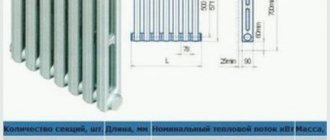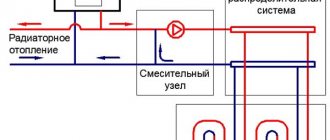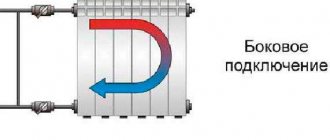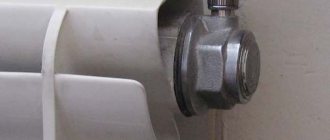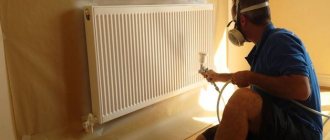Good afternoon, dear readers! Today I will continue the topic of central heating batteries. We will talk to you about the operation of heating batteries. Almost everyone needs this topic, and my task is to help you understand this issue once and for all. So, I hope you have already read my article: Correct installation of a central heating battery in an apartment. We will assume that the battery has been installed for you. What's next?
How to turn on the radiator correctly for the first time
A very important point is to turn on the central heating battery for the first time in your home. When a long period of time has passed, and the thermal power plant begins to supply water to our batteries, then usually the first water flowing through the heating systems is the dirtiest and rustiest. Imagine. You have just installed a brand new battery, one might say, off the assembly line, and suddenly a powerful stream of dirt is thrown in there. It is not surprising that many batteries become clogged precisely from the first such inclusion, and then we are surprised that out of 12 battery bends, only 8 are heated, the rest remain cold. To prevent this from happening, a jumper (bypass) is needed when installing the battery. If you have done the installation correctly, then set the position of the ball valves as shown in the figure:
In this case, the entire flow of dirt when turned on for the first time will go through the jumper, keeping your battery intact and safe. In this option, it is better to keep hot water running for several days. Of course, many are looking forward to when it will be turned on. However, my advice is, if you can’t wait a few days, wait at least one day. By the way, here is a detailed article on how to turn off the battery.
Types of taps for heating equipment
Today, there are several types of taps designed for heating radiators:
- The advantages of the control valve are that without shutting off the water supply system, it allows you to carry out various work with a specific battery; full-bore straight and angular balls made of brass;
- full bore balls made of polypropylene;
- control valves;
- thermostatic valves with manual and automatic control with thermal head.
The most popular and common type of shut-off device is a ball valve made of brass or polypropylene. Such taps consist of a steel ball with a selection of the required diameter for passing water, attached to a stem.
By rotating the ball, the coolant is shut off into the battery. When the tap is opened, the sample in the ball merges with the internal passage of the battery, and when closed, it shifts 90 degrees and blocks it.
The second most common is a standard manual valve , which is a design where the coolant changes flow direction twice when passing through the working section of the seat. To reduce the amount of liquid, this section is blocked by a cone or washer with a rubber gasket attached to the rod.
How to regulate heat in batteries
Suppose you put a battery of 10 bends in the room, and you feel good with it when it’s -20 degrees outside. But now, the cold has passed and now it’s been -2 degrees for several days. Hot water, as often happens with us, at the same temperature continues to flow through our pipes in a powerful stream and a gas chamber is formed in the room, from which there is no escape. In this case, the temperature regulator comes to the rescue. There are many of them in nature. In the picture below you see one of them.
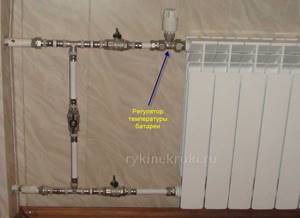
What brand of thermostat should be is the topic of a separate article. And now it is important for you and me to understand the principle. The figure shows one of the simplest thermostats. It has a knob on top that you can rotate and set values from 0 to 5:

5 - means that the entire flow of hot water will pass through the battery; 4, 3, 2, 1 - means that the regulator will reduce the diameter of the flow pipe, providing less hot water flow through the battery per unit time. Thus, at 4 the battery will be colder, at 3 even colder, etc.
If you want to disconnect the battery altogether, you can set it to “*” - the water current will be very small. Practically it will not exist:
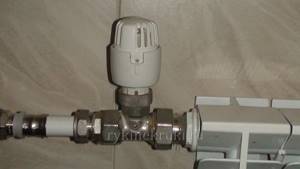
Or you can simply close the ball valves on the battery. The effect will be approximately the same:
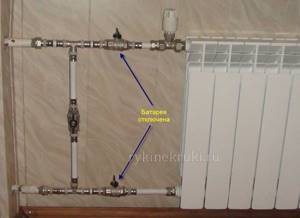
If you have 2 windows in your room and 2 radiators under them, then during installation it is advisable to install them wisely. For example, you need 20 sections for the entire room. Then it is better to put, for example, 12 sections on one battery, and 8 sections on the other. In this case, in addition to the regulator on each battery, you can completely turn off or turn on 8, 12 or all 20 sections at the same time.
Which taps are best to install?
If you do not need special temperature control, then it will be enough to install a regular control valve or ball valve. Such devices are very easy to install and simple to operate. Such taps are installed very often in apartments and houses.
Moreover, ball valves have only two positions, that is, either there is heating or there is not, control valves are able to regulate the flow and thereby reduce or increase the temperature in the house, but with such adjustment it is impossible to measure the exact flow and temperature.
If, on the contrary, complete and, most importantly, precise regulation of the air temperature in the room is required, then it is necessary to install thermostatic valves that can provide this.
Typically, such valves either have graduations corresponding to a certain temperature, and very advanced models have a small display showing the exact temperature, pressure and flow. Such devices are usually more expensive than previous ones, but provide greater comfort and convenience.

Radiator taps
Very important information
Below we will describe situations when one or another inclusion of the battery may be undesirable, and sometimes unacceptable!

4.1.You cannot use the thermostat without a jumper
In point 2 we talked about the thermostat. However, you need to understand that experiments with a temperature controller are only possible with a jumper! If it is not there, and you reduce the diameter of the flow pipe, then the total flow of hot water through your apartment will decrease. Which of course is unacceptable, otherwise your neighbors will come to you!
4.2. The thermostat may become clogged
If you are using a jumper, but for some reason it was turned off for a while and the thermostat was set to position 5, i.e. provided a full flow of hot water only through the battery, as shown in the figure:

then everything seems to be fine. However, we must accept reality as it is. Even if we turned on the central heating radiators correctly for the first time, there is no guarantee that, for example, in a month or two a new mud flow will not pass through the pipes. But then, if the jumper is turned off, then the splash of dirt will go straight to your thermostat, which, in fact, is very sensitive to it. As a result, a blockage forms in the thermostat, and water will not flow into the battery at all. It won’t go into the jumper either, because you closed it. Therefore, in this situation, water will stop flowing through your apartment; in the house, through your heating riser, the water will also stop and begin to cool in the cold. As a result, a squad of evil neighbors, together with the chairman of the HOA or housing cooperative, is guaranteed to enter your apartment.
It is clear that switching on according to the above figure is similarly not acceptable for the regulator positions 4,3,2,1,*
4.3. The jumper must always be on
Make it a rule that it doesn’t matter whether you use a temperature controller or not, but the jumper should always be on. This way, you will always ensure hot water flow through your apartment. When does it make sense to turn off the jumper? For example, when you feel that the battery is clogged. Then you let all the water flow through the battery by disconnecting the jumper. Perhaps a more powerful stream of hot water will be able to push through the stuck dirt. But this needs to be done for a short time and only under your control - you cannot leave the situation like this and go to sleep. The fact is that if the dirt cannot be pushed through, then a congestion will form again: water will not be able to pass through either the battery or the jumper.
4.4. During installation, the thermostat must be installed behind the jumper, i.e. directly in front of the battery
This is mega important, because if it is installed before the jumper, then when you first turn it on, dirt will definitely clog your thermostat, and you will start the heating season with a complete rewiring of the battery:
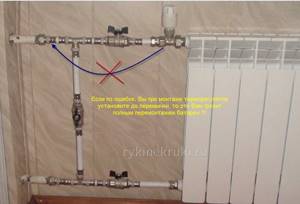
4.5. Avoid outright carelessness when installing ball valves in different positions
This installation of ball valves in your system will again ensure that your neighbors come to you:

You just completely turned off the water :).
Well, that's all, dear readers! I tried to tell you in as much detail as possible about the nuances of operating heating batteries!
Have you ever accidentally blocked the heating pipe in your house?
What to consider when installing taps
When installing various taps, it is necessary to take into account, firstly, personal preferences, that is, whether you want to overpay for more precise temperature control, and secondly, the parameters of the room, house, and so on.
The instructions for installing shut-off valves of various types are very similar to each other. It is imperative to check everything for leaks in order to avoid accidents; you also need to take into account the convenience of using such devices. You shouldn’t waste money on a seal; it’s better to choose trusted manufacturers.
If you do not understand anything about installing shut-off valves, then it is better to consult with a professional about what type of faucet you should install in your home.
The word “faucet” is used when talking about different types of shut-off valves. They also use taps for radiators installed both in apartments and taps for heating radiators in private households.
Is it worth turning off heating appliances?
Attention! Ball valves cannot be used to regulate the flow of coolant if you want to reduce the heating of the batteries! This valve is a shut-off valve; its use for other purposes leads to destruction of the valve and leaks.
Based on the above, if there is no bypass, but ball valves are installed, the battery can be dismantled independently for repair or replacement, but not during the heating season.

Heater with installed bypass
The bypass (jumper) is mounted parallel to the radiator and is usually a pipe whose diameter is equal to the diameter of the supply pipes or one step smaller. If you plan to shut off the radiators after the heating season or install a radiator with a thermostat, be sure to take care of installing a bypass. Otherwise, your actions will lower the temperature of the coolant and your neighbors.
Recommendations for installing devices
To be able to regulate the temperature of the battery in the apartment, consider any type of valve: they can be straight or angular. The installation principle of such a device is simple; the main thing is to correctly determine its position. Thus, the direction of coolant flow is indicated on the valve body. It must correspond to the direction of water movement inside the battery.
Place valves/thermostats at the inlet of the heating device; if necessary, install a tap at the outlet as well. This is done so that in the future it will be possible to independently drain the coolant. Regulating devices are installed on heating radiators, provided that the user knows exactly which pipe is the supply pipe, since a tap is made into it. In this case, the direction of movement of hot water in the riser is taken into account: from top to bottom or from bottom to top.
Compression fittings are more reliable, which is why they are used more often. The connection to the pipes is threaded. Thermostats can be equipped with a union nut. To seal the threaded connection, use FUM tape or flax.
Installation of air vents
A typical tap for a radiator is a product by Mayevsky. The faucet is a simple structure made of a brass rod, which in the closed position covers the hole in the seat, and threads to install it in the radiator plug (for more details: “What is the Mayevsky valve needed for - features of use, characteristics”).
Such taps for heating radiators are reliable and rarely require repair or replacement, but:
- their cross-country ability is low. If you put the faucet on the riser and wait about 10 minutes once a year until the air comes out easily, then it is hardly worth installing such an air vent on the expansion tank of an apartment building with top filling. It is better to give preference to a conventional valve;
- when buying a Mayevsky faucet, you need to choose a product for a screwdriver, and not for a special key, which cannot always be quickly found before starting the heating;
- Some products of this type allow you to unscrew the rod completely; unfortunately, such cases are not uncommon. No one has yet succeeded in screwing the rod into place, overcoming the resistance of the hot coolant.
An alternative to the Mayevsky tap is a drilled radiator plug or an adapter with a screwed-in plug valve. Sometimes, for this purpose, a regular water tap is used, which is placed in an inverted position - with the spout up.
When installing a tap on a heating radiator in this way, you need to remove the handle and knob from the valve, since a small child in the house will be attracted to a bright object, and he will eventually try to turn it. The consequences will be unpleasant.
Disabling radiators without fittings
It is no secret that in most apartments to this day there are old cast iron radiators or steel convectors without any shut-off fittings, which makes it impossible to shut them off during the heating season. Moreover, according to the old heating scheme, convectors in high-rise buildings are connected to risers without straight sections - bypasses. Therefore, if an accident occurs with a coolant leak, you must act as follows:
- Try to provide some kind of container to collect hot water. If the stream flows to the side, wrap a thick cloth over the break site so that the water flows along it into a bucket.
- Call the dispatch service of your heating energy supply company and report the accident.
- While the service personnel are getting there, provide them with access to the basement, find the keys, open the door, and so on.
- Try to block the riser yourself.

A few words about how to properly turn off the heating riser. Find in the basement the heating point of your entrance and vertical pipes embedded in a large-diameter main or into a common collector. Follow where they go to determine the emergency riser, and turn it off with a tap. Contact by cell phone someone in the household who can confirm that the geyser eruption in the apartment has stopped. If you couldn’t find your pipe, close all the valves one by one until you find the one you need.
Attention! Don't try to force yourself on basement valves that are stuck due to rust. When they cannot be closed manually, it is better to wait for a team of plumbers; they will find a way to stop the flow of coolant. Otherwise, a very awkward situation will arise when you also break the main fittings, leaving the apartment building without heat during repairs.
It is also worth considering the question of how to shut off the battery if it is hot in the apartment due to the service provider’s failure to comply with the temperature schedule of the boiler room. It would seem that if there are shut-off valves, the problem is solved by manually closing the taps. But after the temperature in the rooms drops, the valves will have to be opened again. This way you will get tired of turning the taps long before the end of the heating season, so you need to think about how you can adjust the heat output of the radiators. The options are:
- if possible, install a thermostatic valve on each radiator, limiting the flow of coolant and automatically maintaining the set temperature in the room;
- It is nice to cover the heating device with a blank screen with small holes if there are no shut-off valves on the connections.
Important. The ball valve is not a means of adjustment; it is intended only to completely cut off or open the passage of the coolant. In the “half closed” mode it will not give the desired effect and will fail much earlier.
Thanks to worn-out pipelines, district heating systems are notorious for dirty water that quickly clogs small passages. Therefore, ordinary valves with thermal heads will not last long here; you need to buy special valves with increased capacity, which are produced by the well-known brands Danfoss and Herz. How to install them on the connection to the radiator is shown below in the diagram and described in this material.
Adjustment during installation and beginning of the heating season
The initial adjustment of heating radiators in an apartment should be carried out at the installation stage. In particular, in order to prevent the formation of air pockets, radiators are mounted with a slight slope (height difference 3-4 mm) towards the riser and supply pipe. On the other hand, a Mayevsky tap is installed at the top of the battery, with the help of which air is removed. In addition, at the end of the heating season, when water is removed from the system, a slight slope will ensure complete drainage of water from the radiators.
At the beginning of the heating season, if the risers are already hot, but part of the battery does not heat up, then an air bag has formed in the device, interfering with the normal circulation of the coolant. In this case, the air removal procedure is performed using a flat screwdriver. The Mayevsky tap is slowly unscrewed with a screwdriver until all the air comes out and water appears.
Taps that regulate battery temperature
Control valves for heating radiators are of the following types:
- standard;
- with thermal head.
The most successful way to solve the problem with coolant temperature is to install a thermostatic head. After it is adjusted with a trim throttle, it will serve throughout the heating season.
The control valve on the heating radiator will maintain a comfortable temperature in the room. The thermostat is mounted on the supply line of the supply pipe in such a way that the temperature-sensitive element is not subject to heating due to the ascending flow of hot air masses.
A throttle is considered a cheaper option, but it needs to be adjusted manually depending on the required degree of heating of the rooms in the house, which is of course not very convenient. After all, both the radiator and the rooms have great inertia: the air temperature can stabilize only after several hours after the throttle opening is changed.
Also, to regulate the movement of coolant through the supply pipe, a conventional plug valve is used. In principle, it is not intended for this, but with its help, configuration is possible.
Is water needed in the system in summer?
The main condition for long-term proper operation of radiators is the absence of corrosion, which can appear both in empty batteries and those filled with liquid without air access.
In fact, there should be water in the system at all times, regardless of the season. But many service companies neglect this condition and drain it immediately after the end of the heating period.
Utility services justify this by saying that in the summer they carry out repair work, during which the water in the systems interferes and has to be drained. In addition, many residents change radiators during repairs, which also requires a complete release of the system, especially if the entrance has a common riser. And constant filling and emptying causes loss of time and unnecessary financial costs.
But, since the water does not completely drain from the radiators, a humid environment forms inside, leading to deformation of the metal. Therefore, if the service company drains water immediately after the end of the season, the shut-off valves should be closed the day before.
It will be important to open the air bleed valves, which will help avoid excess pressure in the radiators, which most often occurs when the system cools down. The taps should be opened a few days before the start of the next heating season.
Do I need to install taps on radiators?
There is an opinion that if there is no need to regulate the power of the battery, then there is no need to install taps on it. This judgment is not correct... Every heating radiator, sooner or later, needs maintenance or replacement, and without taps this procedure will be more difficult and more expensive. In other words, nothing lasts forever, and this also applies to heating radiators. Each heating device can sooner or later become clogged, lose its appearance (in this case, we can offer you to paint the heating radiator) or fail (leak). If taps are installed in front of the radiator, then dismantling and reinstalling it (or installing a new radiator of the same type) is not a problem. If there are no taps, then servicing or replacing the radiator is a complex and expensive process. Therefore, the answer is definitely yes, you need to install taps on any battery.
Selection of radiator valves
The selection of valves should be made taking into account the following parameters:
- type of locking device;
- technical characteristics of the crane;
- individual characteristics of the heating system.
Types of valves
Three main types of valves are used for installation in a heating system:
- ball;
- conical;
- thermostatic.
Ball valves are installed to autonomously shut off the heat supply and, due to their characteristics, cannot be used to limit the flow of water into the system.
Shut-off ball valves are divided into the following types according to installation method:
- threaded (the taps are equipped with threads on both sides for connection to pipes). They are mainly produced in small diameters and are intended for installation in an individual residential heating system;
Threaded shut-off valve
- flanged (the device is attached using flanges). Used in most cases on external lines of heating systems;
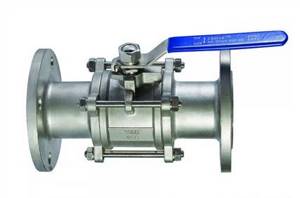
Valve for heating system, secured with flanges
- welded (installed using a welding machine). Due to the complexity of installation, they are practically not used in individual systems.
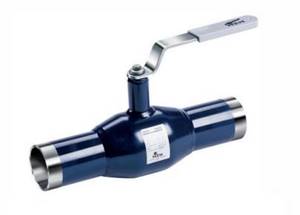
Welding faucet
A cone valve, unlike a ball valve, allows you to regulate the temperature of the incoming liquid. The control valve can be of two types:
- straight. The device is installed on a flat area of the heating system;
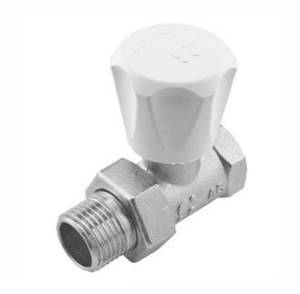
Crane for installation on level ground
- angular. The device is installed at the bend in the supply pipeline.
Tap for installation on pipe bends
To maintain the temperature of the liquid in the heating system, a thermostatic valve is installed, which may have:
- manual control. A certain indicator is set on the temperature scale built into the valve;
- semi-automatic control. Temperature setting is done on the push-button display;
- automatic control. The valve maintains the set temperature without human intervention.
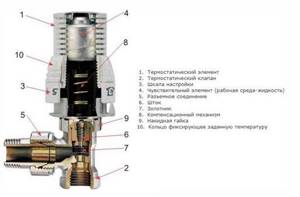
Valve device with adjustable temperature
Which radiator valve to choose? You need to rely on the capabilities of the device:
- complete (shut-off valve) or partial (cone or thermostatic valve) restriction of the incoming liquid;
- setting the temperature.
Standard requirements for valves
Any radiator valve must meet the following requirements, which are standard for urban heating systems:
- valves on heating radiators must withstand an internal fluid temperature of at least 200ºС;
- the operating pressure of the valve installed on the radiator must be in the range of 16 - 40 atm;
- the valve must be made of materials resistant to corrosion and mechanical stress. High-quality taps are made of steel, bronze or brass.

